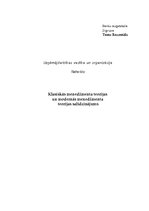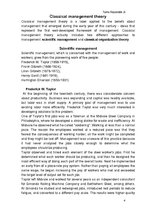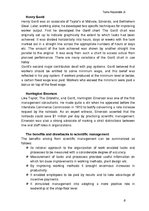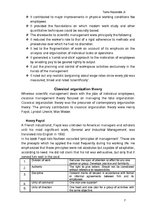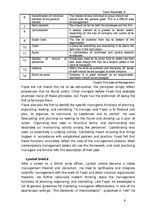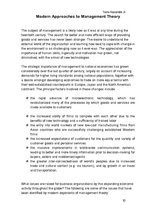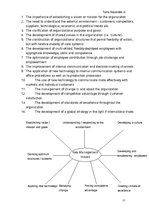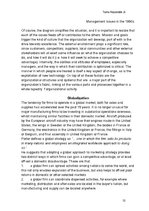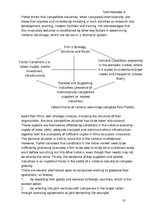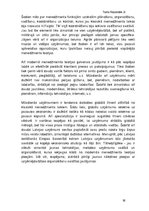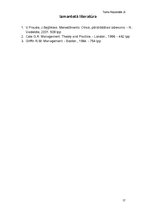-
Classical Management Theory
| Nr. | Chapter | Page. |
| Classical management theory | 3 | |
| Classical organization theory | 6 | |
| Modern Approaches to management theory | 9 | |
| Menedžmenta salīdzinājums un izmantošana mūsdienās | 13 | |
| Izmantotā literatūra | 15 |
Classical management theory is a label applied to the beliefs about management that emerged during the early year of this century - ideas that represent the first well-developed framework of management. Classical management theory actually includes two different approaches to management: scientific management and classical organization theory.
Scientific management
Scientific management, which is concerned with the management of work and workers, grew from the pioneering work of five people:
Frederick W. Taylor (1856-1915),
Frank Gilbreth (1868-1924),
Lilian Gilbreth (1878-1972),
Henry Gantt (1861-1919),
Harrington Emerson (1853-1931)
Frederick W. Taylor
At the beginning of the twentieth century, there was considerable concern about productivity. Business was expanding and capital was readily available, but labor was in short supply. A primary goal of management was to use existing labor more efficiently. Frederick Taylor was very much interested in developing solutions to this problem.
One of Taylor's first jobs was as a foreman at the Midvale Steel Company in Philadelphia, where he developed a strong dislike for waste and inefficiency. At Midvale he observed what he called "soldiering": Working at less than a normal pace. The reason the employees worked at a reduced pace was that they feared the consequences of working harder; all the work might be completed and they might be laid off. Management was unaware of this practice because it had never analyzed the jobs closely enough to determine what the employees should be producing.
Taylor observed and timed each element of the steel worker's jobs. First he determined what each worker should be producing, and then he designed the most efficient way of doing each part of the overall tasks. Next he implemented an early from of a piece-rate pay system. Rather than paying all employees the same wage, he began increasing the pay of workers who met and exceeded the target level of output set for each job.
Taylor left Midvale and worked for several years as an independent consultant for Simonds Rolling Machine Company and Bethlehem Steel, among others. At Simonds he studied and redesigned jobs, introduced rest periods to reduce fatigue, and converted to a different pay scale. The results were higher quality and quantity of output and improved morale. At Bethlehem Steel, Taylor studied efficient ways of loading and unloading railcars and applied his conclusions with equally impressive results.…
Klasiskā menedžmenta teorija :: Zinātniskais menedžments (Taylor, Gilbreths, Gantt, Emerson), Klasiskā organizāciju teorija (Fayol, Urwick, Weber, Barnard) << Angļu valodā >> Modernās menedžmenta teorijas :: Globalization << Angļu valodā >> Menedžmenta teoriju salīdzinājums un izmantošana mūsdienās. << Latviešu valodā >> Kopā - 15 lpp.

